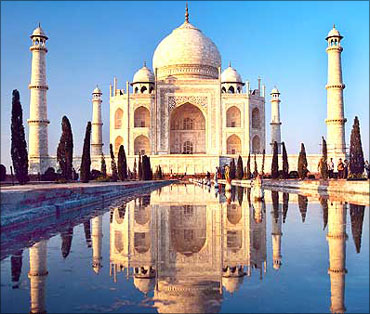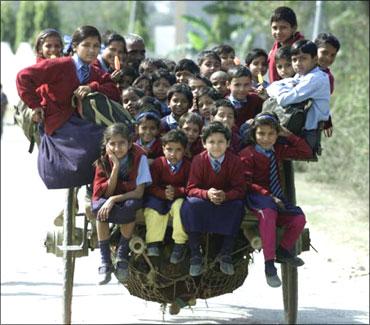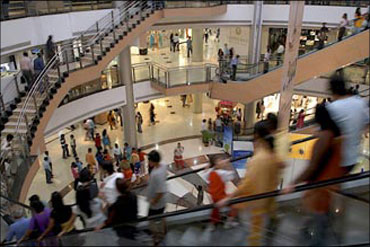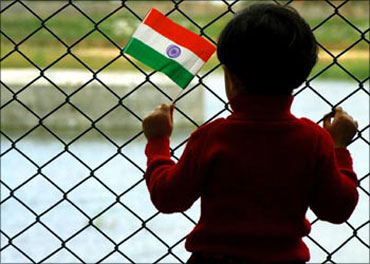 | « Back to article | Print this article |
India then and now: What has changed?
Many of us who rejoice in India's current record as one of the fastest growing economies would have perhaps forgotten that soon after Independence, India had an equally roaring start.
It was a pioneer in development planning, led by Jawaharlal Nehru, one of the most admired figures of the 20th century. What was even more remarkable was that, under government-led planning process with widespread controls, India achieved industrial growth of more than 8 per cent per annum on average between 1954-55 and 1964-65.
And then, it all fell apart. The next 10 years, 1965-66 to 1974-75, were perhaps the darkest period in India's post-Independence history. Industrial growth declined to around 3 per cent per annum, overall growth rate fell to about 2 per cent, and India was faced with frequent balance of payments crises.
India had no option but to go around with a begging bowl for foreign aid to meet its minimum requirements.
Click NEXT to read on. . .
India then and now: What has changed?
By the mid-1970s, there was growing disenchantment with planning and call for liberalisation of the economy. Thus during the presidential address to Parliament on January 5, 1976, the government announced its intention to 'remove controls which were no longer relevant to increase production and widen entrepreneurial base'. However, nothing much really happened to overhaul the prevailing system.
That was then.
Now, fast forward to 2010. It is truly amazing how much India has changed. Instead of being a borrower, it is now a lender to the International Monetary Fund (IMF). Its foreign exchange reserves exceed $270 billion -- one of the highest among developing countries. This would have been unimaginable even 10 years ago.
India is expected to show a growth rate of 8 to 10 per cent, and may emerge as one of the largest economies in the world in the not-too-distant future. Foreign capital inflows are plentiful, and investments exceed one-third of its GDP.
By common consensus, the year 1991, when India was in the midst of an acute balance of payments crisis and had to pledge its gold reserves to meet debt obligations, was the beginning of the 'reform era' which led to a gigantic shift in India's fortunes.
Click NEXT to read on. . .
India then and now: What has changed?
The architect of reforms in 1991 was then finance minister (and current Prime Minister) Manmohan Singh. He was given authority by then Prime Minister P V Narasimha Rao to do whatever was necessary to get India out of its worst crisis.
And he did it with the help of a large structural adjustment loan from IMF and by launching a programme of reforms to liberalise the economy, improve its competitiveness and increase its growth potential.
This much is history.
However, as we look back and try to analyse why the post-1991 policy framework could not be adopted prior to the acute crisis, we are faced with what Lester Thurow describes as a 'riddle wrapped in an enigma inside a conundrum'.
The government that launched reforms in 1991 was formed by the same political party, the Congress, which was also in power during previous decades (with a brief interruption during 1977-79).
Click NEXT to read on. . .
India then and now: What has changed?
In earlier decades, the Congress party had a clear majority in Parliament, and Narasimha Rao was an important member of the Cabinet. The country was also fortunate in having Manmohan Singh at the highest policy-making levels in the ministry of finance in the 1970s and as RBI Governor and deputy chairman of the Planning Commission in the 1980s.
The academic and global policy view in respect of centralised planning had also shifted dramatically in favour of free markets and open economies in the 1980s because of the collapse of Soviet Union, periodic crises in several planned economies, and success of east-Asian economies in achieving high rates of growth by opening their economies and promoting capitalism.
The 'riddle' is really why the same distinguished leaders, the same political party and the same open and democratic government with a vibrant media had to wait until mid-1991, when it was faced with the worst economic crisis, to launch a comprehensive package of reforms to improve external viability and growth. There are no definitive answers to this historical riddle.
However, looking ahead, while overall economic prospects look bright and secure in 2010, it is important to emphasise that there are also several discomforting issues which are emerging and which require attention of the highest authorities in our country -- without delay.
Click NEXT to read on. . .
India then and now: What has changed?
As readers of this paper are well aware, among these are:
- (a) widening disparities among poor in rural and tribal areas, which constitute bulk of India's population, and relatively well-off sections. At the top of the pyramid are, of course, the dollar billionaires whose assets in recent years have grown to 20 per cent of India's GDP (this, by the way, is higher than GDP of the entire agricultural sector);
- (b) increasing lawlessness (with one-third to one-fourth of the districts being dominated by lawless elements according to official figures);
- (c) power of small parties -- with a handful of elected members -- to determine country's political future; and
- (d) erosion in authority of the government to improve governance, reduce corruption and deliver public services.
What is also striking is that all the above issues are interrelated and reinforce each other.
Hopefully, effective action to tackle these 'systemic', and other current problems (such as, inflation), will be taken soon when the country has a stable government with several distinguished leaders -- rather than later in the midst of a crisis. Is UPA-II capable of taking such remedial action?
The author is chairman, Centre for Development Studies, and former RBI Governor.





